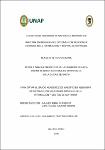| dc.contributor.advisor | Reátegui Pezo, Alejandro | |
| dc.contributor.author | Riera Gutierrez, Galileo | |
| dc.contributor.author | Campos Crispin, Lizth Yulisa | |
| dc.date.accessioned | 2025-06-26T16:09:01Z | |
| dc.date.available | 2025-06-26T16:09:01Z | |
| dc.date.issued | 2025 | |
| dc.identifier.other | X | |
| dc.identifier.uri | https://hdl.handle.net/20.500.12737/11508 | |
| dc.description.abstract | The present study addresses the problem of solar radiation prediction in the city of Nauta, considering its importance for applications in renewable energy and climate management. The main objective was to develop a predictive model based on LSTM artificial neural networks and the RandomForestRegressor machine learning algorithm, seeking to improve accuracy by reducing the root mean square error (RMSE) and increasing the correlation coefficient (R). The methodology included the collection of historical meteorological data from SENAMHI, which were preprocessed, normalized and segmented into training, validation and test sets. The models were configured and trained using machine learning techniques and recurrent neural networks. The results showed that the LSTM model obtained an RMSE of 25.94 and an R of 0.764 during training, while the RandomForestRegressor achieved an RMSE of 27.25 and an R of 0.740. However, when using untrained data, the RandomForestRegressor showed a higher generalization capacity with an RMSE of 27.38 compared to 30.04 for the LSTM. It is concluded that both models are effective for predicting solar radiation, highlighting the robustness and adaptability of the RandomForestRegressor and the ability of the LSTM to capture complex temporal patterns. It is recommended to expand the database and adjust hyperparameters to improve the performance of the model in different geographical environments. | en_US |
| dc.description.abstract | El presente estudio aborda el problema de la predicción de la radiación solar en la ciudad de Nauta, considerando su importancia para aplicaciones en energía renovable y gestión climática. El objetivo principal fue desarrollar un modelo predictivo basado en redes neuronales artificiales LSTM y el algoritmo de aprendizaje automático RandomForestRegressor, buscando mejorar la precisión mediante la reducción del error cuadrático medio (RMSE) y el aumento del coeficiente de correlación (R). La metodología incluyó la recolección de datos meteorológicos históricos del SENAMHI, los cuales fueron preprocesados, normalizados y segmentados en conjuntos de entrenamiento, validación y prueba. Los modelos fueron configurados y entrenados utilizando técnicas de aprendizaje automático y redes neuronales recurrentes. Los resultados mostraron que el modelo LSTM obtuvo un RMSE de 25.94 y un R de 0.764 durante el entrenamiento, mientras que el RandomForestRegressor alcanzó un RMSE de 27.25 y un R de 0.740. Sin embargo, ante datos no entrenados, el RandomForestRegressor mostró mayor capacidad de generalización con un RMSE de 27.38 frente a 30.04 del LSTM. Se concluye que ambos modelos son efectivos para la predicción de la radiación solar, destacando la robustez y adaptabilidad del RandomForestRegressor y la capacidad del LSTM para capturar patrones temporales complejos. Se recomienda ampliar la base de datos y ajustar hiperparámetros para mejorar el rendimiento del modelo en diferentes entornos geográficos. | es_PE |
| dc.format | application/pdf | es_PE |
| dc.language.iso | spa | es_PE |
| dc.publisher | Universidad Nacional de la Amazonía Peruana | es_PE |
| dc.rights | info:eu-repo/semantics/openAccess | * |
| dc.rights.uri | https://creativecommons.org/licenses/by/4.0/ | * |
| dc.subject | X | es_PE |
| dc.subject | X | es_PE |
| dc.subject | X | es_PE |
| dc.subject | X | es_PE |
| dc.title | Modelo para la predicción de la radiación solar a partir de redes neuronales artificiales en la ciudad de Nauta | es_PE |
| dc.type | info:eu-repo/semantics/masterThesis | es_PE |
| thesis.degree.discipline | Maestría en Ingeniería de Sistemas con Mención en Gerencia de la Información y Gestión de Software | es_PE |
| thesis.degree.grantor | Universidad Nacional de la Amazonía Peruana. Escuela de Postgrado | es_PE |
| thesis.degree.name | Maestro(a) en Ingeniería de Sistemas con Mención en Gerencia de la Información y Gestión de Software | es_PE |
| dc.subject.ocde | https://purl.org/pe-repo/ocde/ford#2.02.04 | es_PE |
| renati.author.dni | 46857453 | |
| renati.author.dni | 44552970 | |
| renati.advisor.orcid | https://orcid.org/0000-0003-3901-7240 | |
| renati.advisor.dni | 06182363 | |
| renati.type | https://purl.org/pe-repo/renati/type#trabajoDeInvestigacion | es_PE |
| renati.discipline | 612297 | es_PE |
| renati.level | https://purl.org/pe-repo/renati/level#maestro | es_PE |
| renati.juror | Garcia Cortegano, Carlos Alberto | |
| renati.juror | Ramírez Villacorta, Jimmy Max | |
| renati.juror | Puga de la Cruz, Jorge | |
| dc.publisher.country | PE | es_PE |





